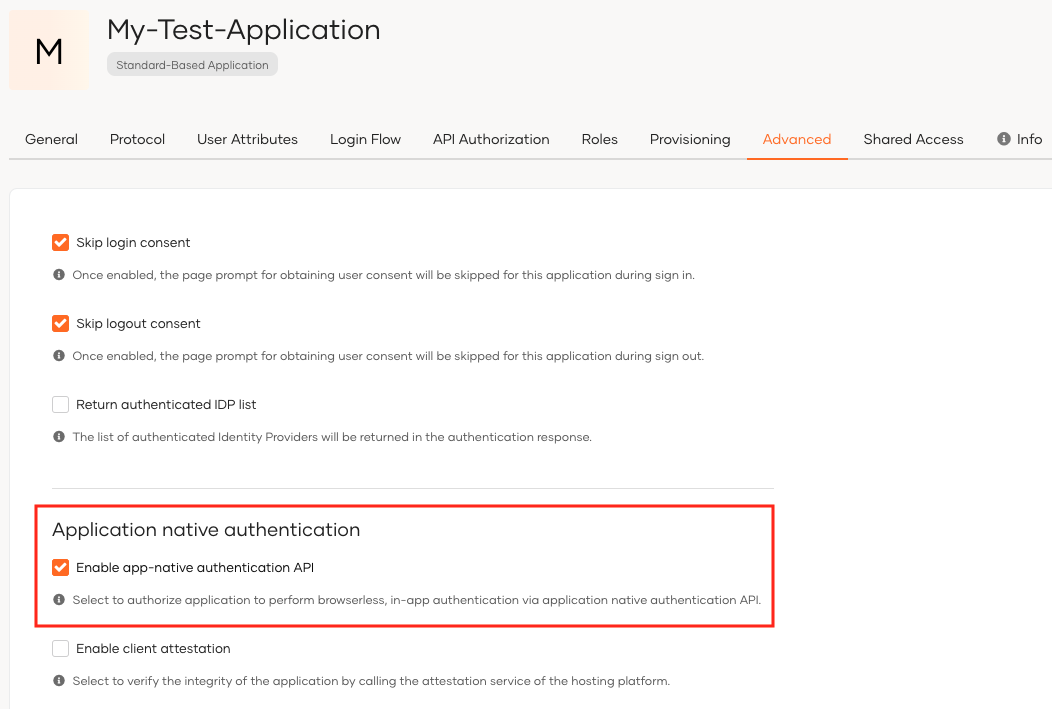Add application-native login¶
In a conventional mobile application, users are typically redirected to an external web browser during login. However, with app-native authentication, developers can integrate a seamless api-based authentication mechanism within the application itself so that users are never taken out of the context of the application.
As app-native authentication is an extension to OAuth 2.0, it also offers many of the flexibility and security features that the OAuth 2.0 protocol offers.
Limitations of app-native authentication
App-native authentication has the following limitations compared to a browser-based OAuth 2.0 flow:
App-native authentication,
- does not prompt the user to provide consent to share user attributes with the application.
- does not prompt the user to provide missing mandatory attributes.
- does not support prompts in adaptive authentication flows.
- cannot be initiated if a non API-based authentication method is configured for the application.
- cannot enroll authenticators (e.g. TOTP authenticator) during authentication.
The following guide explains how you can implement app-native authentication for your application using WSO2 Identity Server.
Prerequisites¶
-
To get started, you need to register an application with WSO2 Identity Server.
-
You need to have a user account in WSO2 Identity Server. If you don't already have one, create a user account in WSO2 Identity Server.
Enable app-native authentication¶
Follow the steps below to enable app-native authentication for your application.
-
On the WSO2 Identity Server Console, go to Applications.
-
Go to the Protocol tab and select Code from Allowed grant types.
-
Go to the Advanced tab of your application and select Enable app-native authentication API.

-
Configure client attestation settings according to the platform that hosts your application.
Note
Learn more about client attestation in the secure app-native authentication documentation.
-
Click Update to save the changes.
Initiate an app-native authentication request¶
App-native authentication is an extension to the OAuth 2.0 protocol. Therefore, the initial request made by the application is similar to a typical OAuth 2.0 authorization code request with a single difference; the response_mode parameter is set to direct.
The request made by the client to the WSO2 Identity Server will be as shown below.
curl --location 'https://localhost:9443/oauth2/authorize/'
--header 'Accept: application/json'
--header 'Content-Type: application/x-www-form-urlencoded'
--data-urlencode 'client_id=<client_id>'
--data-urlencode 'response_type=<response_type>'
--data-urlencode 'redirect_uri=<redircet_url>'
--data-urlencode 'state=<state>'
--data-urlencode 'scope=<space separated scopes>'
--data-urlencode 'response_mode=direct'
curl --location 'https://localhost:9443/oauth2/authorize/'
--header 'Accept: application/json'
--header 'Content-Type: application/x-www-form-urlencoded'
--data-urlencode 'client_id=VTs12Ie26wb8HebnWercWZiAhMMa'
--data-urlencode 'response_type=code'
--data-urlencode 'redirect_uri=https://example-app.com/redirect'
--data-urlencode 'state=logpg'
--data-urlencode 'scope=openid internal_login'
--data-urlencode 'response_mode=direct'
Note
Learn more about the authorization code grant in the documentation.
When the response_mode is set to direct as shown above, all subsequent requests after the initial request to the /authorize endpoint will be directed to the /authn endpoint.
Note
App-native authentication uses the authentication API which is an open API that does not require any form of authentication. Learn about this API and the methods you can implement in the application-native authentication documentation.
Handle SSO with app-native authentication¶
With app-native authentication there are two ways that Single Sign-On (SSO) can be handled for user sessions.
Cookie based SSO¶
App-native authentication, just as the OAuth authorization code flow, sets an SSO cookie (commonAuthId). If the cookie is preserved, any subsequent authorization request that occurs with this cookie will automatically perform SSO.
SessionId based SSO¶
SessionId parameter based SSO is useful if the implementation does not manage session cookies. The id_token that the application receives after the initial authentication request, contains the isk claim. When making a subsequent authorization request the isk value can be used as the sessionId for SSO to occur.
Given below is a sample authorization request using the isk value as the sessionId
curl --location 'https://localhost:9443/oauth2/authorize/'
--header 'Accept: application/json'
--header 'Content-Type: application/x-www-form-urlencoded'
--data-urlencode 'client_id=<client_id>'
--data-urlencode 'response_type=<response_type>'
--data-urlencode 'redirect_uri=<redirect_url>'
--data-urlencode 'state=<state>'
--data-urlencode 'scope=<space separated scopes>'
--data-urlencode 'response_mode=direct'
--data-urlencode 'sessionId=<isk claim obtained from the id_token>'
curl --location 'https://localhost:9443/oauth2/authorize/'
--header 'Accept: application/json'
--header 'Content-Type: application/x-www-form-urlencoded'
--data-urlencode 'client_id=VTs12Ie26wb8HebnWercWZiAhMMa'
--data-urlencode 'response_type=code'
--data-urlencode 'redirect_uri=https://example-app.com/redirect'
--data-urlencode 'state=logpg'
--data-urlencode 'scope=openid internal_login'
--data-urlencode 'response_mode=direct'
--data-urlencode 'sessionId=77961448dd65199ec519fee4685553fe153e9d7bb80e26e41cb5cedc89a2b731'
Note
If both cookie based SSO and SessionId based SSO are configured in the implementation, cookie based SSO takes precedence.